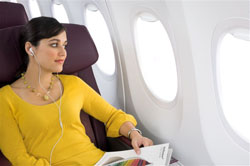Apr 28 2009
Boeing [NYSE: BA] today announced that seven airlines will be the first to incorporate the new, spacious 737 Boeing Sky Interior starting in late 2010. The interior features soft, blue-sky-like lighting overhead.
 With Boeing's [NYSE:BA] new 737 Boeing Sky Interior, the sculpted walls and window reveals direct the passenger's eyes to the view outside the window - the place where passengers say they most experience the thrilling sense of flying
With Boeing's [NYSE:BA] new 737 Boeing Sky Interior, the sculpted walls and window reveals direct the passenger's eyes to the view outside the window - the place where passengers say they most experience the thrilling sense of flying
The airlines are:
- FlyDubai - Dubai, United Arab Emirates
- Continental Airlines - Houston
- Norwegian Air Shuttle ASA - Fornebu, Norway
- Malaysia Airlines - Kuala Lumpur, Malaysia
- TUI Travel PLC - London
- GOL Airlines - Sao Paulo, Brazil
- Lion Air - Jakarta, Indonesia
787 Style in the World's Leading Single-Aisle Airplane
Drawing from years of research used to design the interior for the 787 Dreamliner, the 737 Boeing Sky Interior features new, 787-style modern sculpted sidewalls and window reveals that draw passengers' eyes to the airplane's windows, giving passengers a greater connection to the flying experience. On a more practical note, the sidewall design integrates the air vent so that before-flight security checks go more quickly for maintenance staff.
The new design offers larger, pivoting overhead stowage bins that add to the openness of the cabin. The bins give more passengers room to store a carry-on roll-aboard near their own seat, adding both extra convenience and extra legroom.
Boeing redesigned reading-light switches so passengers can find them more easily and avoid accidentally pressing the flight-attendant call button. Speakers are integrated into each row's passenger-service unit to improve sound and clarity of public address operations, while the new integrated air vent and improved noise-dampening materials reduce overall cabin noise.
More efficient, more clean
Changes to the Next-Generation 737 are more than cosmetic: Boeing is targeting a 2 percent reduction in fuel consumption by 2011 through a combination of airframe and engine improvements. Airplane structural improvements will reduce drag on the airplane, reducing fuel use by about 1 percent. Boeing's engine partner, CFM, is contributing the other 1 percent fuel savings through hardware changes to its engine. Continental Airlines will make a Next-Generation 737-800 available to Boeing to flight test the performance improvements.